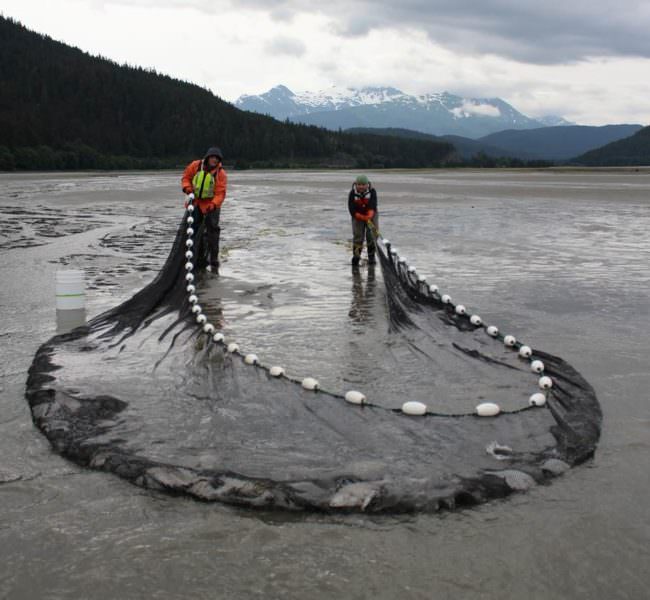
Southeast Alaska is home to hundreds of glaciers and a lucrative fishing industry. As those glaciers retreat, the freshwater they send into the ocean could begin to dry up. Scientists are trying to figure out how that will impact the marine environment.
The gut lab at the University of Alaska Fisheries Department in Juneau has all the traces of its namesake: fish parts preserved in jars of yellow ethanol. But none of the smell.
Masters student Doug Duncan lifts open a cooler to show off this morning’s catch.
“We’ve got our one lone fish in here. And as you see, it’s a small one,” Duncan said.
It’s a baby chum salmon, no bigger than an anchovy. Typically, the scientists are trying to catch predator fish to bring back to the lab. And juvenile salmon are sometimes along for the ride, too, in the bellies of those larger fish. This little guy didn’t meet that fate.
But Anne Beaudreau, an ecologist at UAF, said figuring out how hatchery salmon end up becoming lunch is a little like playing detective.
“Sometimes I like to talk about stomach content analysis of fish like forensics because piecing together clues of what it was when it was eaten,” Beaudreau said. “It’s totally like CSI Fish.”
It’s not the only mystery Beaudreau’s team is trying to solve with fish guts. This study builds on another one that looked at glacial estuaries.
About five years ago, Beaudreau moved from Seattle to Juneau, and she was curious about what she saw.
“I was really struck by the fact that you can be out on the water in the marine environment and looking at a glacier that’s really not that far away,” Beaudreau said. “Thinking about with glaciers melting and receding rapidly throughout Southeast, Alaska, all of that water is going somewhere.”
Eventually, it ends up in glacial estuaries. Beaudreau set out to find what type of fish lived in those waters and what they were eating.
Freshwater glacial runoff mellows out the salinity of the ocean water, which is good for some kinds of fish. Plus, it can wash down debris, like leaves, that the fish like to eat.
Beaudreau said scientists compared what fish were eating in estuaries near glacial rivers to those in rain-fed creeks.
“As glacial systems transition to more rain-fed systems, it kind of gives us a window into what the future might look like,” Beaudreau said.
It also helps scientists establishing a baseline — something to contrast the future with, which right now is crucially important. Most of the world’s glaciers are losing ice because of climate change.
Beaudreau said scientists know that it’s happening. What they don’t know is how that melt will affect the marine environment. But one thing this study does prove is the interconnection between land or glacier and sea.
Still, Beaudreau said more research is needed to answer the big question: what does that mean for fish? And she said a lot is riding on the answer.
“Not even the million dollar question, the billion dollar question,” Beaudreau said. “I think that the work that we’re doing is a really important start.”
The research is on pause while Beaudreau looks for new funding for the project.
In the meantime, her team is working on the hatchery study, and she’s also holding on to tissue samples, in the hopes of someday continuing the one on glacial estuaries.
But right now, it’s not easy to find federal dollars for climate change research.
“A lot of people are concerned about the ability to keep this work funded,” Beaudreau said.
She said her team will keep investigating the stomachs of predator fish.
“Every little study that we do is just one piece of a bigger puzzle,” Beaudreau said.
A puzzle, she said, that will take a lot more scientific research to solve.




